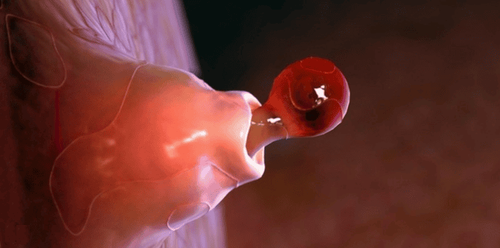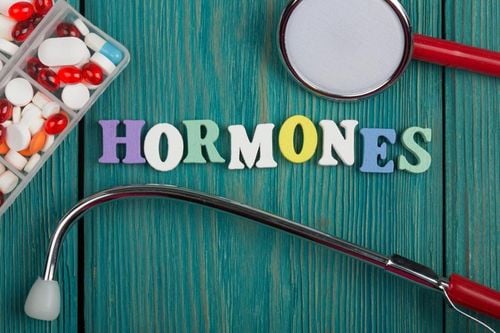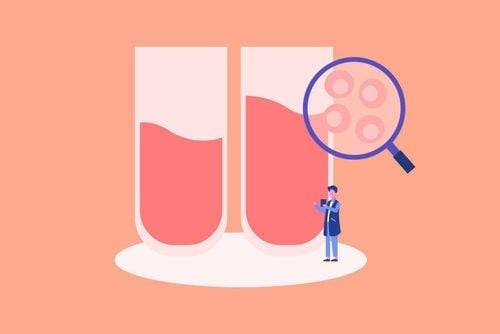This is an automatically translated article.
Ovulation disorders often lead to infertility, up to 40% of female infertility cases are caused by ovulatory disorders. Normally, every month, an egg follicle in a woman's ovary grows to a certain size, ripens and then releases, or ovulates. Ovulation disorders are irregular ovulation, which interferes with the natural process of conception.1. What is Ovulation Disorder?
Normally at the end of each menstrual cycle due to the action of hormones FSH and LH make primordial follicles in the ovary develop (about 6-7 follicles), after a few days under the influence of hormones these follicles will increase size.
After about 7-8 days of development, there are some follicles that will grow faster and others will gradually recede. In the rapidly growing follicles, the size of the follicles grows rapidly and the amount of estrogen secreted from these follicles also increases significantly. At the end of the follicular proliferative phase, due to the increased amount of estrogen, there is a positive feedback effect on the pituitary hormones FSH and LH causing the pituitary gland to increase secretion of these two hormones.
Under the action of FSH and LH, it makes the follicles grow strongly to a size of about 1.8-2.3 cm, which is called mature follicle.
Before ovulation, the amount of LH and FSH hormones secreted by the pituitary gland increases suddenly, due to the action of these two hormones, the follicles swell while the follicle wall is thin and weak, so the follicle will burst and release ovum out of the follicle. Ovulation usually occurs 13-14 days before menstruation. Ovulation disorder is a condition caused by many causes resulting in the phenomenon of ovum not being released according to a certain cycle, irregular shedding thereby causing menstrual disorders which is the leading cause of infertility. female birth.
Treatment of ovulatory disorders depends on the cause of the ovulatory disorder. In most cases of ovulatory disorders, the treatment is to restore the ovulatory function of the ovaries, which must use drugs that stimulate the development of ovarian follicles. Usually, the pregnancy rate achieved after each cycle of ovarian stimulation is about 30%. Ovarian stimulation is usually not done too many times on a patient, so it does not affect the patient's health.

Thông thường, tỷ lệ có thai đạt được sau mỗi chu kỳ kích thích buồng trứng khoảng 30%
2. Causes of Ovulation Disorder
Due to abnormalities in the hypothalamic pituitary endocrine system As it is known that ovulation is closely related to the two hormones LH and FSH secreted by the pituitary gland, the secretion of these two hormones is controlled by the hypothalamic GnRH hormone. , so a certain reason leads to the suppression of GnRH hormone, which directly affects ovulation. In some cases, the hormone prolactin is elevated in the blood, leading to menstrual disorders in the luteal phase. Ovulation and eventually amenorrhea due to complete suppression of GnRH.
Abnormal reverse regulation In addition to being controlled by the hormone GnRH, FSH and LH are under the opposite effect of the hormone estrogen. Estrogen is involved in negative and positive upregulation of these two hormones.
Negative feedback means that at the end of the menstrual cycle the amount of estrogen drops suddenly, causing the pituitary gland to increase secretion of LH and FSH with the intention of increasing the amount of estrogen. If estrogen does not decrease at this time, there will be no reverse regulation, FSH and LH will not progress, which means that the follicles cannot develop. At the normal ovulation stage, estrogen will increase, causing positive reverse regulation (ie, even though the estrogen hormone is at a high threshold, it still stimulates more FSH and LH secretion) thereby causing ovulation. If at this stage the estrogen is not high enough, it is not enough to create a feedback.
Ovarian abnormalities Like polycystic ovary disease, ovarian tumor, after ovarian dissection surgery ...
3. Consequences of Ovulation Disorder

Rối loạn phóng noãn có thể làm suy giảm ham muốn tình dục
4. How is Ovulation Disorder Diagnosed?
In people with ovulation disorder, there may be some symptoms such as: Irregular menstruation, prolonged menstruation, no menstrual period for a long time, abnormal changes in uterine mucus, decreased libido. sexual desire, obesity, hirsutism... But this expression may not be found in some people to make an accurate diagnosis based on subclinical tests.
4.1 Ultrasound Ultrasound helps to monitor follicular development. Especially, transvaginal ultrasound is an effective tool to help evaluate the function, physiology and pathology of the ovaries. Ultrasound monitoring of follicles should be performed several times in a cycle. This is a simple, inexpensive, and painless method for the patient. Currently, ultrasound is widely used and has high efficiency.
4.2 Estrogen Test This test is done on the 2nd or 3rd day of the menstrual cycle.
Estrogen levels gradually increase in the blood during the follicular phase, reaching peak concentrations just before the onset of the LH peak and 36 hours before ovulation. It is a female sex hormone that plays a very important role and is produced in the ovaries. The follicles in the ovaries secrete estrogen which triggers the reproductive cycle.
Progesterone Progesterone quantification is the most widely used method for diagnosing ovulation. When the level of progesterone in the blood is greater than 10 ng/ml, it is more likely that ovulation will occur. However, there are many controversies regarding the single or multiple quantification and timing of progesterone quantification. In addition, it is possible to quantify the metabolite of progesterone in the urine.
LH LH is usually done on the 2nd or 3rd day of the menstrual cycle. Abnormal changes in LH levels as well as changes in mid-cycle LH peaks may suggest an abnormal cause of the luteal phase.
FSH is the hormone responsible for stimulating egg production. If the FSH level is high, the ovarian reserve is low, the risk of polycystic ovary syndrome
Prolactin Prolactin inhibits reproductive hormones, specifically follicle-stimulating hormone (FSH) and gonadotropin-releasing hormone (GnRH). Therefore, the phenomenon of increased prolactin also causes ovulation disorders. Ovarian disorders are the leading cause of difficulty getting pregnant, and can also cause endometrial or ovarian cancer complications. Therefore, as soon as abnormalities are detected, women should see a specialist for timely diagnosis, diagnosis and treatment.
Vinmec International General Hospital provides customers with a basic gynecological screening package, helping to detect diseases even when there are no symptoms and treat menstrual problems, the risk of Ovarian cancer according to the regimen best suited to the disease condition, in order to bring the best results for the patient's health.
Please dial HOTLINE for more information or register for an appointment HERE. Download MyVinmec app to make appointments faster and to manage your bookings easily.













